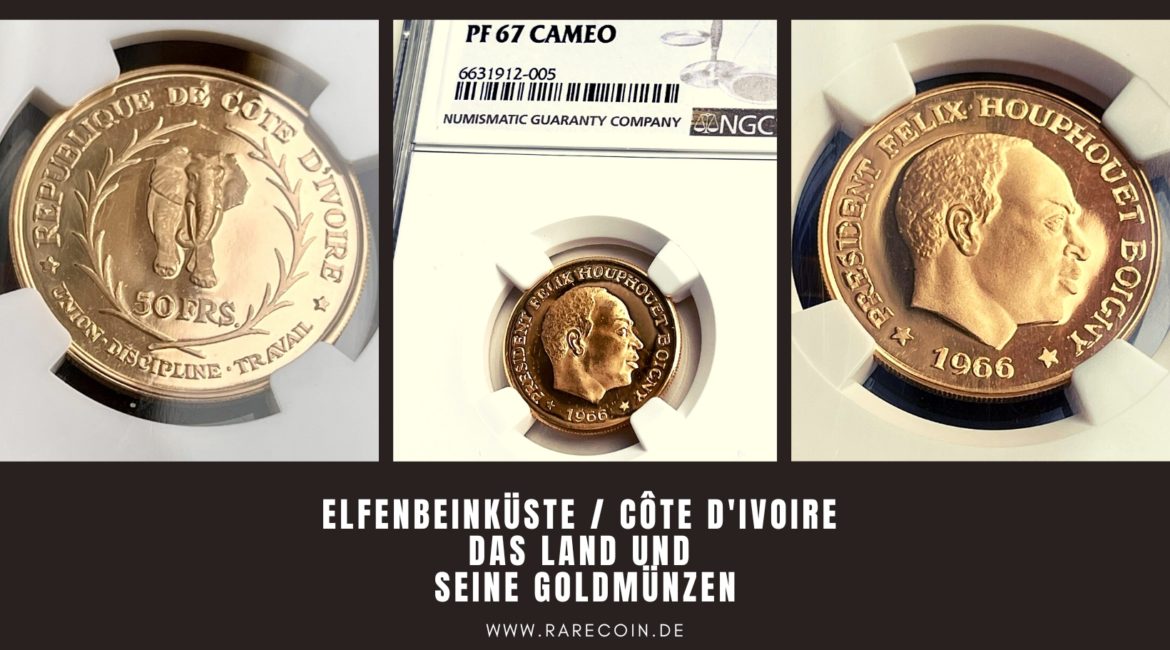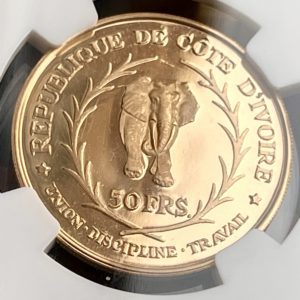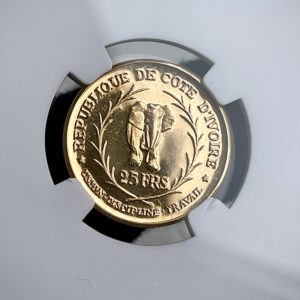Côte d’Ivoire, officially known as the Republic of Côte d’Ivoire, is a West African country on the southern coast of the Gulf of Guinea. It is a diverse and vibrant country with a rich cultural heritage, breathtaking natural landscapes and a fascinating history. In this blog we will explore some interesting facts about Ivory Coast and its gold coins.
Size: The population of Côte d’Ivoire is 28.243 million as of March 2023.
Capital: Yamoussoukro, the largest city and economic center is the port city of Abidjan.
Geography and climate: Côte d’Ivoire is located in West Africa and borders Guinea, Liberia, Burkina Faso, Mali and Ghana. The country has a total area of 322,462 square kilometers and is divided into 14 regions. Ivory Coast has a tropical climate with two distinct seasons: a dry season from November to March and a rainy season from April to October. The country is predominantly flat, with some mountains in the northwest and plateaus in the central region.
Population and languages: Côte d’Ivoire has a population of about 26 million people belonging to more than 60 ethnic groups. The largest ethnic group in the country is the Akan, followed by the Baoulé, Bété and Senufo. The official language of Côte d’Ivoire is French, but many other local languages are spoken, including Baoulé, Dioula and Bété.
Culture: Ivory Coast is known for its diverse and rich culture that includes music, dance, art and cuisine. The country’s music is diverse and includes genres such as Zouglou, Coupe-Decale and Yacouba. Ivory Coast is also famous for its traditional dances, including the zaouli, a mask dance, and the goli, a dance performed at important ceremonies.
Ivorian cuisine: The country’s cuisine is a mix of African and European influences and includes dishes such as attieke, a cassava-based dish, and fufu, a staple made from cassava or sweet potatoes. Ivory Coast is also known for its coffee and cocoa production, and Ivory Coast coffee beans are highly sought after.
Economy: Côte d’Ivoire is one of Africa’s fastest growing economies and has a GDP of $55 billion. The country’s economy is driven by agriculture, which accounts for 25% of GDP and employs about two-thirds of the labor force. Côte d’Ivoire is the world’s largest producer of cocoa, and its main agricultural exports include coffee, rubber and palm oil.
Côte d’Ivoire has a developing manufacturing industry that includes textiles, food processing, and chemical production. The country is also an important hub for West African trade, with the port in Abidjan serving as a gateway to the region.
History: Côte d’Ivoire has a rich and complex history dating back to the Paleolithic. The country was home to several powerful kingdoms, including the Ashanti and Baoulé empires. In the late 19th century, Ivory Coast came under French colonial rule and was administered as part of French West Africa. The country gained independence in 1960, and its first president, Felix Houphouet-Boigny, ruled for more than three decades, ushering in a period of stability and economic growth. In 1999, a coup d’état occurred in Côte d’Ivoire, leading to a period of political instability and civil conflict. Since then, the country has undergone a period of reconciliation and has made progress in rebuilding its political and economic institutions.
Who was Felix Houphouet-Boigny?
Felix Houphouet-Boigny was a well-known politician and the first president of the Ivory Coast. He was born on October 18, 1905, in Yamoussoukro, a small town in the Ivory Coast. He belonged to the Baoule ethnic group and was the son of a wealthy farmer. You can see his face on the gold coins below.
Houphouet-Boigny attended a Catholic missionary school in Bingerville, Ivory Coast, and then continued his studies at the Sorbonne in Paris, France. He studied medicine, but later switched to law and became a lawyer. In the 1940s, Houphouet-Boigny became involved in politics and founded the African Democratic Assembly (RDA), a political party that sought to unify the French-speaking countries of West Africa. He was elected to the French National Assembly in 1946 and served as Côte d’Ivoire’s deputy until the country’s independence in 1960. After Côte d’Ivoire’s independence, Houphouet-Boigny became the country’s first president and remained in power until his death in 1993. He played a key role in shaping the country’s political and economic landscape and implemented policies aimed at promoting economic growth and stability.
One of his most important achievements was the construction of the new capital Yamoussoukro, which he envisaged as a symbol of Ivory Coast’s prosperity and modernity. The centerpiece of the city is the Basilica of Our Lady of Peace, a massive structure inspired by St. Peter’s Basilica in Rome.
Houphouet-Boigny was known for his diplomatic skills and was a major figure on the world stage. He played a key role in the creation of the Organization of African Unity (OAU) to promote unity and cooperation among African countries.
Despite its achievements, however, Houphouet-Boigny’s regime was not free of critics. He has been accused of corruption and authoritarianism, and his government has been charged with human rights violations.
Houphouet-Boigny died at his home in Yamoussoukro on December 7, 1993. He was a controversial figure who left a lasting mark on Ivory Coast and the entire African continent. Although his legacy is still controversial, it is undisputed that he had a significant impact on the political and economic landscape of Côte d’Ivoire.
Gold coins from Ivory Coast
Ivory Coast gold coins are coveted by collectors and investors alike for their exceptional craftsmanship and unique design. These coins are minted from high quality gold and feature intricate designs depicting the rich cultural heritage of Côte d’Ivoire. Ivory Coast gold proof coins are usually minted in limited quantities, which makes them very valuable and popular for collectors.
One of the gold coins from Ivory Coast is the Ivory Coast – 50 Francs Gold Proof – 1966 – Felix Houphouet-Boigny. It has a limited edition of only 2000 pieces and was certified by the NGC and given a very high grade of PF69 Ultra Cameo, making it very valuable and collectible.
Another highly sought after gold coin from Ivory Coast is the Ivory Coast – 25 Francs Gold Proof – 1966 – Felix Houphouet-Boigny. The gold coin has a limited mintage of only 2000 pieces and has been certified by the NGC and graded with a very high PF67 Ultra Cameo.
Aside from their unique design and limited mintage, Ivory Coast gold coins also offer excellent value for investors.
In summary, Ivory Coast gold coins are highly valued by collectors and investors alike due to their exceptional craftsmanship, unique design and limited mintage. These coins offer excellent value for investors and are an ideal investment for those looking to diversify their portfolio and hedge against economic uncertainty.
Discover our Ivory Coast gold coins here:
-
Ivory Coast – 1966 – 25 Francs – Felix Houphouet-Boigny – 8g Proof Gold – NGC PF67 Cameo
975,00 €plus shippingDelivery Time: approx. 2-3 days (excluding Saturdays, Sundays and public holidays)







